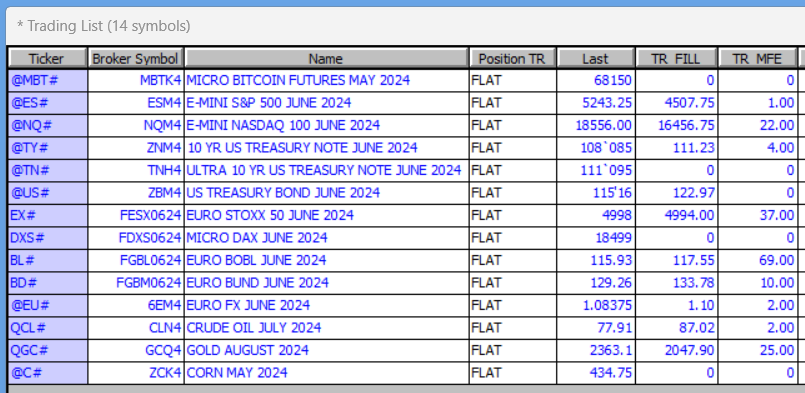Supported Brokerages and Order Routing Systems
| Configuration | Trade from Charts | Server Side OCO/OSO support | Server Side Trailing Stops | Visualize Positions on Charts |
|---|---|---|---|---|
| Rithmic | Yes | Yes | Yes | Yes |
| CQG | Yes | Yes | Yes | Yes |
| Interactive Brokers | Yes | No | No | Yes |
Trading checklist
Step one : Configure your Brokerage Destination
1) If you are using a brokerage data source (ie Rithmic, CQG or Interactive Brokers) as main real time market data source for Investor/RT, then you will be executing orders to the same server as the one you are getting the live data from, ie for example, if you are connected to a Rithmic paper trading account provided by a broker or a prop firm, then the order will be executed to the corresponding rithmic servers.
2) if you own a subscription to IQFEED and use it as the primary data source, you have then the ability to use any of the supported brokerage destinations listed above set as the Brokerage Destination for order routing. For example, an IQFEED user can trade a CQG or Rithmic account directly from Investor/RT charts while also charting equities and indexes of interest. The broker position feedback in the charts would reflect any trading in the associated brokerage account in this example.
For IQ feed subscribers, the destination brokerage can be modified through the "Data > Configure Data Source/Broker" as explained here
Step 2 : Update the generic "Trading list" QuotePage (and check, for IQ feed subscriber, your broker symbol)
Make sure any symbol you wish to trade is added to the quotepage titled "Trading List". (Object Manager: QuotePage: Trading List)
For an IQ feed subscriber, you may want to add the "Broker symbol" column to quickly view the associated broker symbol (Rithmic in the screenshot below)

If you are using IQ feed as live feed, you have indeed to make sure the DTN symbol is setup with the proper Brokerage Alias. For instance, the IQFEED symbol @ES# should be setup with broker alias ESZ4 (adjusted based on current front month). Also, ensure the correct override exchange is specified. You can edit these properties by opening the Setup Instruments window (right-click in chart and choose Setup > Instrument or press Alt-A). Then click on the More button at bottom left to access the Advanced Settings that include the brokerage alias symbol and override exchange. You can add the “Broker Symbol” column to the Trading List QP to quickly check (and possibly adjust) all broker instrument names (that you may recover in our Symbol Guide). For cross-instrument trading, please refer to this forum post
Trading using the ChartTradingDOM or the ChartMiniTrader interfaces
Right-click in any chart, select the menu "Trade" and choose either the ChartTradingDOM or the Chart MiniTrader. It will appear at the right in a sidebar pane. Note : the legacy "Trading Order Desk" feature is still accessible, but we recommend using one of these 2 newer interfaces, especially as these support the OCO/OSO Trading strategy features.
Opening a position with chart Buttons triggering specific "Trading Order" actions
Press Alt-O to open the Object Manager and choose Trading Orders as the Object Type. This displays a list of existing Trading Orders. Use the Object Manager window to Create, Edit or Delete Trading Orders. To execute a Trading Order from any chart using a chart button, right click any chart and choose Add Button. Then set the Button Purpose to Execute a Trading Order. Then select your Trading Order from the list that appears.
Review this Trading from the charts with Buttons video for more information about this feature and learn how to submit a stop or limit order through a simple mouse click on a chart.
Setting or Adjusting Target and/or Stop Loss Orders Levels with the Mouse
After you have placed an order using any of the methods described above, Investor/RT will place a working order line on your chart that can be adjusted by either dragging it or selecting it and using the up and down arrows on your keyboard. Pressing the "X" on the line will cancel any unfilled limit orders or, if the line represents an active position, pressing the X will immediately send a market order to flatten the position.
Right clicking any working order line will offer additional options depending on the nature of the line such as Cancel, Flatten, Adjust, or place Stops and Targets with the Mouse.
Using OCO/OSO "Trading Strategies"
For attaching one or multiple pairs of combined stop and target orders (OCO / One Cancel the Other) to a Trading Order setup, or entering a new position through a bracket order (OSO - Order Sends Orders), please review the Trading Strategy feature
Using RTL Trading tokens
Learn more about the RTL tokens dedicated to trading orders and positions and create custom live feedback features on ongoing trades or custom order management features
Embedding Trading orders within the live "Trading System" indicator
Learn more about this Trading system indicator and review the corresponding 3 part video series to explore its full capabilities in terms of Automated trading systems

